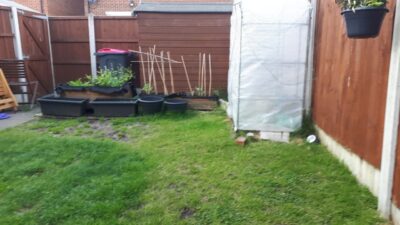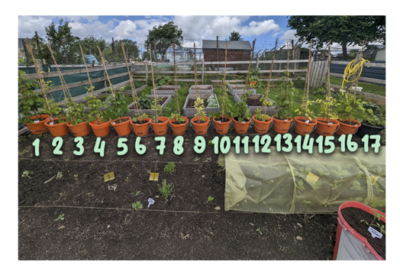Top Tips for Harvesting
By harvesting crops in the right way, damage can be reduced and so waste is minimised. In some cases productivity can continue with a cut-and-come-again approach. A little and often approach to harvesting is much easier for the home grower.
Daily trips to the fruit and veg patch will allow crops to be selected when they are deliciously young and juicy. If left too long in the ground lettuces will bolt and become bitter tasting while beans might become stringy. They can be eaten absolutely fresh and full of goodness that can decline when stored on the supermarket shelf. Regular observations prevent crops from ‘going over’ and becoming less palatable.
- Lift beetroot by grabbing the lower stems on every other plant to allow the others to grow
- The leaves of the beetroot can also be eaten, with younger leaves suitable for salads and older leaves great for stir-fry
- Potatoes are best lifted after flowering, but be careful not to skewer them
- Asparagus is best cut 2.5cm below the soil surface every 2-5 days over 8 weeks in mid-spring
- Sweetcorn can be pulled when the tassels turn brown by twisting the cob after pulling back the protective leaves
Storing Fresh Produce
As a home grower of vegetables, you have the advantage of being able to prioritize taste and nutrition over shelf life. By harvesting your crops correctly, you can reduce damage, minimize waste, and even encourage continued growth through a “cut-and-come-again” approach. There are several methods for preserving summer fruits and vegetables, while onions, potatoes, and root vegetables are best stored in dark, dry, and airy places.
For hardy root vegetables like celeriac, parsnips, and others, you can simply cover them with a layer of straw, fleece, cardboard, or hessian sacking over the winter months in the soil. Beetroot, swedes, carrots, and turnips should be stored in boxes of sand or peat in a cool, dark shed or garage. It is crucial that these places are dark, dry, and cold, but not freezing, to ensure the vegetables are still safe to eat.
Shelf life for different vegetables:
- Onions: 1 to 2 months in summer; 6 months in winter
- Carrots: 4 to 8 weeks depending on the variety
- Potatoes: 1 to 2 weeks at room temperature; 2 to 3 months when kept in a cool, dark place
- Beetroot: 4 to 8 weeks; cut off the tops to prevent drawing out nutrients and moisture
- Cabbage: 2 months when properly wrapped in plastic and stored
- Butternut Squash: 2 to 3 months when kept cool and dry
Remember to maintain hygiene and cleanliness, preserve food as soon as possible after harvesting, avoid using damaged or overripe food, and label your stored items so you can keep track of what you’ve preserved and when. If jars smell musty or appear slimy and mushy, the contents are likely no longer edible.
Storing Potatoes
Potatoes can be stored cooked, but there are ways to store raw potatoes as well. To do so:
- Lift main-crop potatoes on a dry day and allow them to dry
- Choose undamaged tubers and store in a cool, dry place in a double-layered paper sack or wooden box
- Avoid plastic containers and keep potatoes away from light to prevent them from turning green
Storing Roots
Most roots can be left in the ground until needed, even over winter. To store roots:
- Place undamaged roots in a shallow wooden box with slight moisture
- Store against a wall outside in a clamp covered with straw and soil
- Be mindful of rodents when storing roots in this manner
Freezing
Freezing is a great way to store excess vegetables and bring back the aromas of summer during the winter.
- Clean and freeze herbs like fennel, basil, and parsley in bags or ice cube trays
- Most fruits and vegetables freeze well, but for best results, freeze as soon as possible
- Blanch vegetables before freezing to stop enzyme activity and prevent spoilage
- Use wax paper, plastic containers, or freezer-safe glass jars to store frozen produce
Don’t forget, you can also freeze ready-made recipes made from your fresh produce. Enjoy the taste of home-grown vegetables all year round!
Preserving
There are also a variety of other methods to use when preserving the food that you grow in your garden.
Canning
Canning is an excellent option for preserving your own home-grown food and allowing you to enjoy it for years after harvest. The process involves boiling, cooling, and storing fruits or vegetables in airtight glass containers.
There are several methods used for canning, including:
- Pressure Canning: This method requires specialized equipment to reach temperatures above 212°F (100°C) in order to prevent bacterial growth in most vegetables and low-acid foods. High-acid foods, such as fruits, are much easier to can.
- Boiling Water Canning: This method involves packing a canning jar with fruits, leaving an inch of space at the top for expansion, and boiling the jar in water for 10-20 minutes, depending on your altitude. To ensure airtight sealing, remove any air bubbles with a spoon, and close the jar with a threaded lid.
- Pickling: Another way to preserve your home-grown vegetables is through pickling, which involves using salt and/or vinegar as a preservative.
Before using any canning method, it is important to sterilize your jars to kill any bacteria. You can do this by using sterilizing tablets or by placing the jars and lids in the oven at the lowest temperature for 30-45 minutes.
With proper canning storage, both fruits and vegetables will last up to 5 years. So why not give canning a try and enjoy your home-grown produce for years to come!
Drying and Dehydrating Food
Dehydrating or drying your food is a great way to ensure that it lasts for years, rather than just a few months. Almost all fruits, vegetables, and even meats can be dehydrated to preserve their freshness. The lack of water content in dehydrated food reduces the risk of bacterial, yeast, or mould growth.
To dehydrate your food, you can use a dehydrator or an oven. However, this can be a time-consuming process, with drying times ranging from 6 to 10 hours, depending on the moisture content of the food. When using an oven, it’s important to have the lowest temperature possible, ideally between 120°F to 145°F (~49-63°C). If your oven does not have options for lower temperatures, you can leave the door open to let air circulate and allow the moisture to escape.
The typical shelf life of dehydrated food is as follows:
- Fruits: 5 years
- Vegetables: 10 years
To ensure maximum freshness and longevity, it’s important to consider a few tips:
- Maintain good hygiene and sterilise containers when necessary
- Preserve food as soon as possible after harvesting
- Avoid using damaged or over-ripe food
- Label your preserved food with the date and contents
- If the jars have a musty smell or look slimy and mushy, the contents are likely no longer edible and should be discarded.
By following these tips, you can ensure that your dried and dehydrated food stays fresh for years to come!
The above are just some examples, however, there is a plethora of information online, as well as many incredibly helpful books available to help to inform and inspire! Other methods to explore include:
- Canning
- Pickling
- Pressure canning
- Sweet preserves, jams, jellies and marmalades
- Chutneys
- Ketchups and sauces
- Lacto-fermentation
- Dehydrating
- Salting
- Smoking
- Preserving in alcohol
- Preserving in oil
- Charcoal houses
- Root stores
- Vacuum sealing




